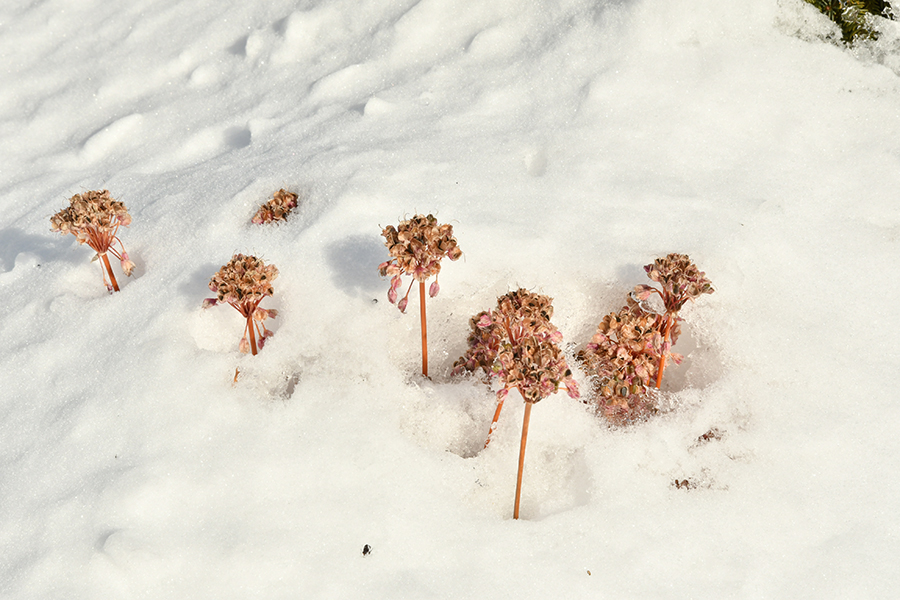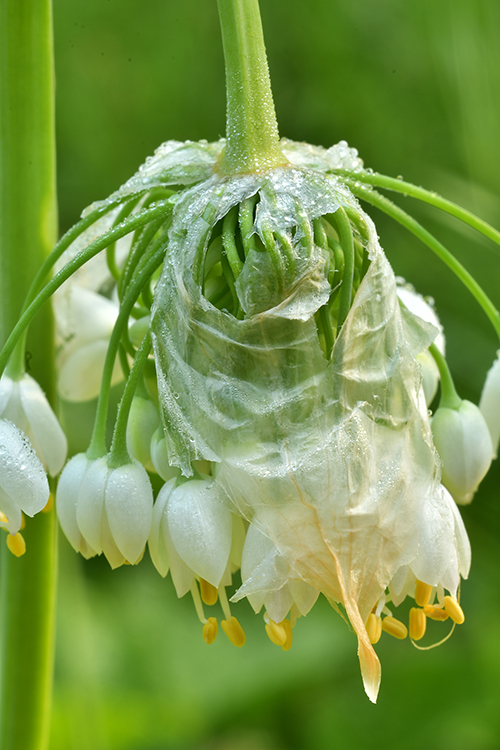
Onions are a plant most people consider as a flavorful addition to meals while the more ardent of gardeners recognize their potential for colorful spring bulb displays. The selections many gardeners have yet to discover are the species and crosses available for late summer and autumn bloom. Indeed, the mighty Onion, botanically known as Allium has much to offer the autumn garden!
Allium is a huge genus and often the differences between the various species are barely discernable, which explains the range in potential species from 250 to over 950. Once considered a member of the Lily Family, it is currently assigned to the Amaryllidaceae or Amaryllis Family with the majority of the species found in temperate regions throughout the northern hemisphere. The name Allium is Latin for Onion and was officially ascribed to the genus by the Swedish botanist Carl Linnaeus (1707–1778) in 1753 when he established cultivated garlic, Allium sativum as the type plant for the genus. The species epithet of sativum is from the Latin for cultivated.
Allium species are characterized by overwintering and growing from an underground structure of modified leaves called a bulb. In some species the bulb forms at the end of a rhizome or horizontal root while a few species have tuberous roots composed of modified stems. Allium is also characterized by strong aromatic compounds containing sulfur, providing the characteristic fragrance of garlic in the bulb, stem and flower. This fragrance is also helpful in preventing deer predation! Lastly, they are characterized by flowers in the form of umbels, whereby the individual floral stems, botanically called pedicels radiate outward from a central point like a starburst. The pedicels are often all of equal length, but not always. The flowers are typically campanulate or bell-shaped and are composed of six tepals in which the three outer sepals of the calyx and three inner petals of the corolla look virtually identical, with all six serving to attract pollinators.
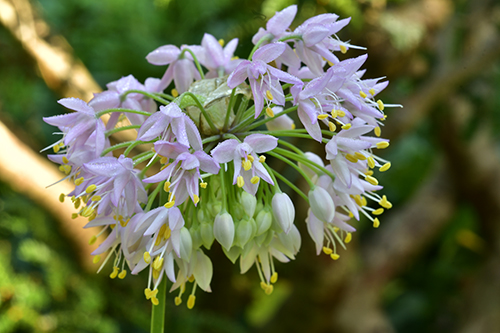
One interesting species that is native to much of the United States, northern regions of Mexico and parts of Canada is Allium cernuum or Nodding Onion. It was named and described by the German Physician and Botanist Albrecht Wilhelm Roth (1757–1834) in 1798. The species epithet is from the Latin meaning 'face turned towards the earth' or 'stooping', a physical attribute also echoed in the common name. The foliage appears as open clumps of flat, grass–like leaves growing from 8–18" long, depending upon the soil fertility. Unlike most spring bloomers, the foliage persists throughout the growing season. The flower stems and buds begin to appear in mid-July.
The upper portion of the stems are initially rather limp in appearance (Picture 1) with the upper half of the stem completely bent over and the flower bud facing downward, a stature befitting of its botanical and common names. As the umbel nears the point of opening in late July and August, the floral stem 'unrolls' upwards, drawing the flower bud higher and higher as it starts to swell. The transparent leafy outer covering of the flower bud, called the spathe, splits open as the bud begins to make its final rise upwards (Picture 1), allowing the individual flowers to tumble outwards. When the flower is finally upright, the flowers radiate outward in the characteristic ball shape of an umbel as seen in Picture 2. A very dramatic process!
Flowers can reach 12–36" tall with the taller flowers found in soils with greater humus and fertility levels. The ¼" diameter flowers are pink, lavender and white in color, with upwards of forty individual flowers per umbel. In mass, they create quite the impact and look great mixed with low sedges and other grassy foliaged plants. The flowers are beloved by pollinators, with each umbel effective for upwards of four weeks and followed by the development of small black seeds. Plants can rapidly naturalize in the years to come to the point of becoming weedy and in small garden areas it may prove beneficial to deadhead the flowers before seed set. The plants naturally occur in rocky soils in open woods, dry meadows and prairies, where their spreading nature is actually very becoming.
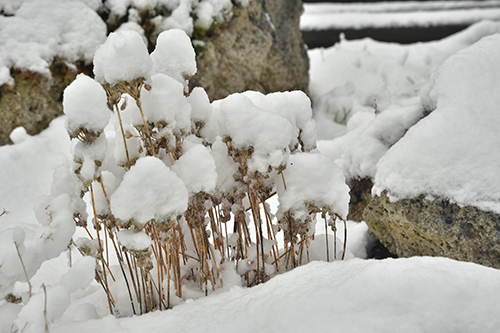
Blooming slightly later is Allium thunbergii, the Japanese Onion. Native to Japan, Korea and coastal regions of Eastern China, this species normally blooms from September into October in NJ. The foliage is once again grass-like, stretching to 12" tall with numerous 1½" diameter rosy purple and balloon-like umbels floating above. Flowers reach heights of 15–18". Once the blooms fade the floral impact continues to be of interest well into winter as the stems turn to orange while the seed heads retain a distinct pink coloration. The stiff stems hold up well to snow and look remarkable with a dusting of snow, as seen in Picture 3 and Picture 8. The plant was originally named Allium odorum in 1784 by the Swedish naturalist and physician Carl Peter Thunberg (1743–1856), from specimens he collected during his visit to Japan during 1776.
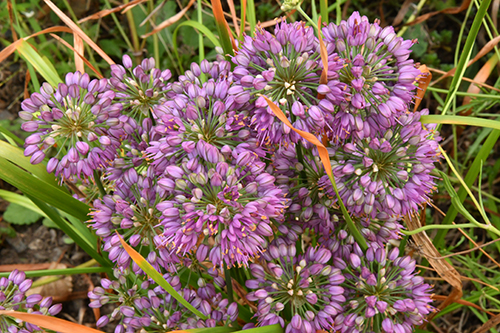
The Scottish Botanist George Don (1798–1856) thought this name to be rather ambiguous, since all species of Allium are odiferous and renamed the plant to honor Thunberg in 1827. Don was greatly intrigued by the genus and published a monograph on Allium several years later in 1832. The selection that is currently most available in the trade is 'Ozawa' (Picture 4). It was introduced by author and nurseryman George Schenk of Washington State at some point prior to 1980. Presumably, the name honors the individual or nursery providing the selection. It offers a slightly shorter stature than the species with larger, 2–2½" rosy purple flowers. On the outer surface of the tepals is a central dark green to purple line that provides added interest on close inspection.
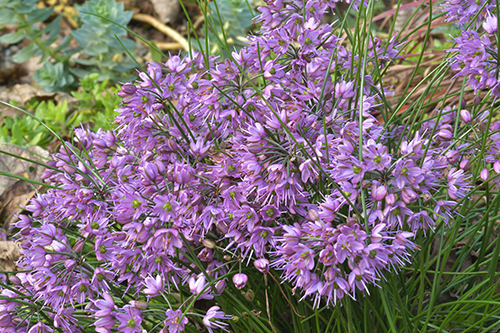
Blooming later yet is Allium kiiense or Kii Garlic that is still in bloom in the middle of November and able to tolerate 16 degrees of frost without any visible impact to the floral display. Originally named Allium virgunculae var. kiiense in 1952 by the Japanese botanist Gen Murata (1927–2020), the name was changed in 2009 since the flowers fail to form spherical umbels, preferring to present the flowers horizontally, as if the flower buds only form around the equator line of the globe (Picture 5).
With such small differences between species, it is easy to see how there is such a huge range in the potential number of Allium species! The plant is native to the Kii Peninsula on the island of Honshū Japan, along with the nearby prefectures of Gifu, Aichi and Yamaguchi. The flowers are rosy pink with a green central rib down the outside of the tepals. The flowers are far less numerous than the previous species, averaging around 10–14 per umbel. However, the individual flowers are also larger than those of its cousins, reaching ½" in diameter when open, allowing a small clump to provide a nice splash of late autumn color. The flowers also prove to be attractive for pollinators, since there are few plants in flower at this time of the year. The numerous 6–8" tall floral stems are produced over the very slender, round and grassy foliage of roughly the same length, although it rarely arches above 3–4" tall. The foliage is evergreen, usually assuming attractive red tones throughout the winter. With few people shopping while it is in bloom, this species will most likely never become mainstream. However, for the garden it is hard to beat the late season color and it is a great addition for rock gardens or other well-drained locations. I have yet to see any seedlings develop, as the seeds may not mature in NJ before the onset of winter's frigid temperatures.
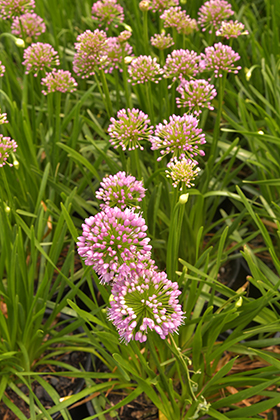
Aside from these species, there are numerous hybrids on the market that provide the garden with late summer color along with great flowers for pollinators. Probably the most recognized is Allium 'Millenium' (Picture 6), the Perennial Plant of the year for 2019. In case you were wondering, 'Millenium' is the proper spelling with one 'n' and is the result of the breeding efforts of Mark McDonough, an architect by trade who has been fascinated with the genus Allium since High School! The selection was introduced in 2000 through Plant Delights Nursery of Raleigh, NC. The parents include Allium nutans and Allium lusitanicum, with the flattened appearance of the foliage stemming from the Allium nutans parent and the dark green from Allium lusitanicum. The foliage grows to 10–15" tall. Each bulb produces 2–3 flower scapes, with each scape topped by a 2" diameter, deep rose purple umbel. Hardy from zones 5–8, the attractive floral display lasts for upwards of 4 weeks and the flowers are also a favorite among pollinators. Although rare, seedlings have been known to occur.
Another good Flowering Onion for late summer is Allium 'Pink Planet' (as seen in Picture 7 at Cornell Botanic Garden). Offering pink flowers that may not be planet sized, but with diameters upwards of 3" it is one of the largest selections blooming from August into September. The umbels have pale lilac or pink coloring and once again are very popular with various pollinators. There is a nice separation between flowers and foliage, with flowers stretching to 18" tall above the 8" tall foliage. The plants also display vigorous growth with the clumps slowly spreading to 2' across over 10 years. It produces few if any seedlings and the dried flower heads look great against winter snows.
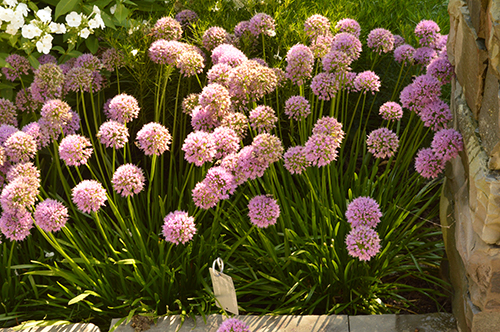
All these Allium species and crosses prefer well-drained soils in full or, at the very minimum, afternoon sun. Allium thunbergii 'Ozawa' is very adaptable and will tolerate moister soils, although it may have difficulty outcompeting weeds in moist locations. Due to the hybrid vigor, 'Millenium' and 'Pink Planet' are ideal for use as an edging plant or used in mass, complimented with spiky flowered plants like Russian Sage (Perovskia atriplicifolia) or small to mid-sized ornamental grasses. Allium kiiense is best in a gravel scree where the low mounding foliage will not be overwhelmed with taller plants and its evergreen nature can best be appreciated. With its heavy seeding nature, Allium cernuum is best located along a woodland edge or in more natural designs with low sedges where it can freely naturalize.
Without doubt, the mighty onion is a genus that can serve many functions equally well. I could not imagine eating cottage cheese without a handful of chopped chives or not having the harlequinesque blooms of the spring blooming selections in a mixed border. Yet, it is the more delicate species and robust hybrids of late summer and autumn that help to carry gardens into winter as Allium thunbergii 'Ozawa' illustrates well in Picture 3 and 8. Without doubt, the Mighty Onion is a gardener's friend in the fall—and beyond!
